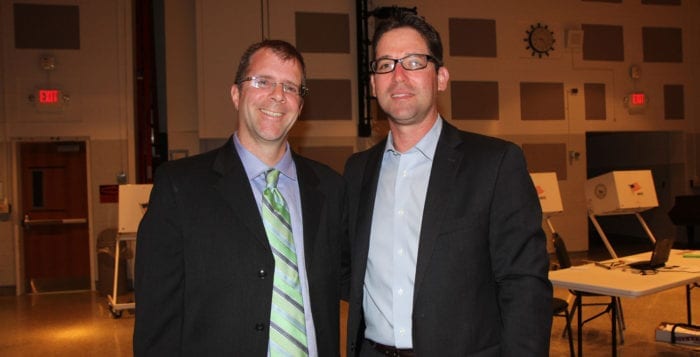By Victoria Espinoza
After months of requests from residents that Huntington go greener, the town board took steps at the its last meeting to make Hecksher Park and Town Hall “green zones.”
At the May 9 meeting the board voted unanimously to approve a resolution establishing a research program to look into replacing gas fueled landscaping equipment with battery operated units at Heckscher Park and Town Hall to reduce emissions and noise.
A green zone is an area maintained with zero-emission lawn care equipment.
The resolution was co-sponsored by Supervisor Frank Petrone (D) and Councilwoman Susan Berland (D). The plan includes retaining the American Green Zone Alliance to conduct a study that will analyze the town’s existing landscaping practices, recommend the appropriate cost-effective, battery powered equipment and instruct town personnel on the use, care and maintenance of the devices.
Berland has been working for months to pass a resolution to limit gas powered leaf blowers due to the health and environmental concerns associated with them.
“This resolution is a great first step to protecting our environment and reducing air and noise pollution in our Town,” Berland said in a statement. “Many constituents have contacted me to restrict the use of gas powered leaf blowers to address their quality-of-life concerns.”
“It is in perfect alignment with our town’s clean energy community policy. Huntington is showing once again its commitment to sustainable initiatives.”
— Bonnie Sager
She encouraged residents to visit the town’s website to watch a public service video she created last year meant to inform community members about the drawbacks of leaf blowers and presents possible alternatives. The website also features a survey to gauge the public’s reliance or disapproval of using leaf blowers.
“I look forward to working together with Huntington CALM and the American Green Zone Alliance to create a ‘green zone’ at Heckscher Park and Town Hall,” she said. “Huntington has always been a beautiful place to live, work and raise a family. Let’s keep it that way.”
Groups like Huntington Citizens Appeal for Leafblower Moderation, and the American Green Zone Alliance have been vocal about the health issues, like asthma and hearing damage, that have been tied to use of gas powered blowers, according to the World Health Organization.
At the meeting, several residents applauded the efforts of the board to improve the situation.
Bonnie Sager, cofounder of Huntington CALM spoke at the meeting.
“The 2,000 plus Huntington CALM supporters and I would like to thank you for bringing forth this resolution,” she said at the meeting. “It is in perfect alignment with our town’s clean energy community policy. Huntington is showing once again its commitment to sustainable initiatives.”
Sager listed the many ways switching to electric equipment would save taxpayers money, as well as eliminate airborne pollutants.
“Hecksher Park is a crown jewel of Huntington serving our residents and guests with the museum, the duck pond, the concert venue and more,” she said. “By becoming a green zone our jewel will shine even brighter.”
The American Green Zone Alliance is based in California and is a leader in a nationwide effort to help communities address noise and air pollution issues. It provides certification and accreditation in zero-emission landscape maintenance strategies; educates individuals, property owners, and landscape maintenance professionals to reduce or eliminate the use of gasoline powered maintenance equipment in favor of cordless electric and manual equipment; and promotes those strategies through its green zone certification program that allows the owners of properties of any size to create, maintain, and promote their own zero-emission green zone. It is working with the Town of Southampton on a similar project.
Petrone said he was grateful for the community participation in this effort.
“I appreciate Huntington CALM’s efforts to raise our consciousness about the environmental effects and health dangers of gas powered landscaping equipment, including significant noise pollution,” Petrone said in a statement. “Heckscher Park and Town Hall are perfect locations for a demonstration program to test the feasibility and efficiency of battery powered equipment that reduces emissions and operates at significantly lower decibel levels than gas powered equivalents. I look forward to seeing, and not hearing, the results.”









 Chris Kelly is running for a third-time, hoping to finally secure a seat. Kelly has been working in the market data business for the past 19 years, and said he wants to bring his professional skills to add something “unique” to the board.
Chris Kelly is running for a third-time, hoping to finally secure a seat. Kelly has been working in the market data business for the past 19 years, and said he wants to bring his professional skills to add something “unique” to the board. Anila Nitekman said she moved from Manhattan to Greenlawn because of the strong reputation the district had.
Anila Nitekman said she moved from Manhattan to Greenlawn because of the strong reputation the district had. Steinberg said he is eager to continue the work of the board, which he said has been very successful lately, including the creation of a new technology initiative.
Steinberg said he is eager to continue the work of the board, which he said has been very successful lately, including the creation of a new technology initiative. Lauri Levenberg has been a district resident for more than 20 years, and said she has the insight to help lead the school in a positive way.
Lauri Levenberg has been a district resident for more than 20 years, and said she has the insight to help lead the school in a positive way. “I still have a passion for it,” she said in a phone interview. “We should be taking enthusiastic 5-year-olds and making them into
“I still have a passion for it,” she said in a phone interview. “We should be taking enthusiastic 5-year-olds and making them into Loughran said he started attending school board meetings in February when the board was able to approve the nearly $40 million bond.
Loughran said he started attending school board meetings in February when the board was able to approve the nearly $40 million bond. A Long Island native, Herbert worked as a public school kindergarten teacher in Massachusetts for several years and is currently the director of the pre-school program at St. John’s Nursery School in Huntington village.
A Long Island native, Herbert worked as a public school kindergarten teacher in Massachusetts for several years and is currently the director of the pre-school program at St. John’s Nursery School in Huntington village.  In 2008, Palacios purchased and renovated a distressed property in Huntington Station where he established a satellite law office along with a community revitalization non-profit organization.
In 2008, Palacios purchased and renovated a distressed property in Huntington Station where he established a satellite law office along with a community revitalization non-profit organization.













